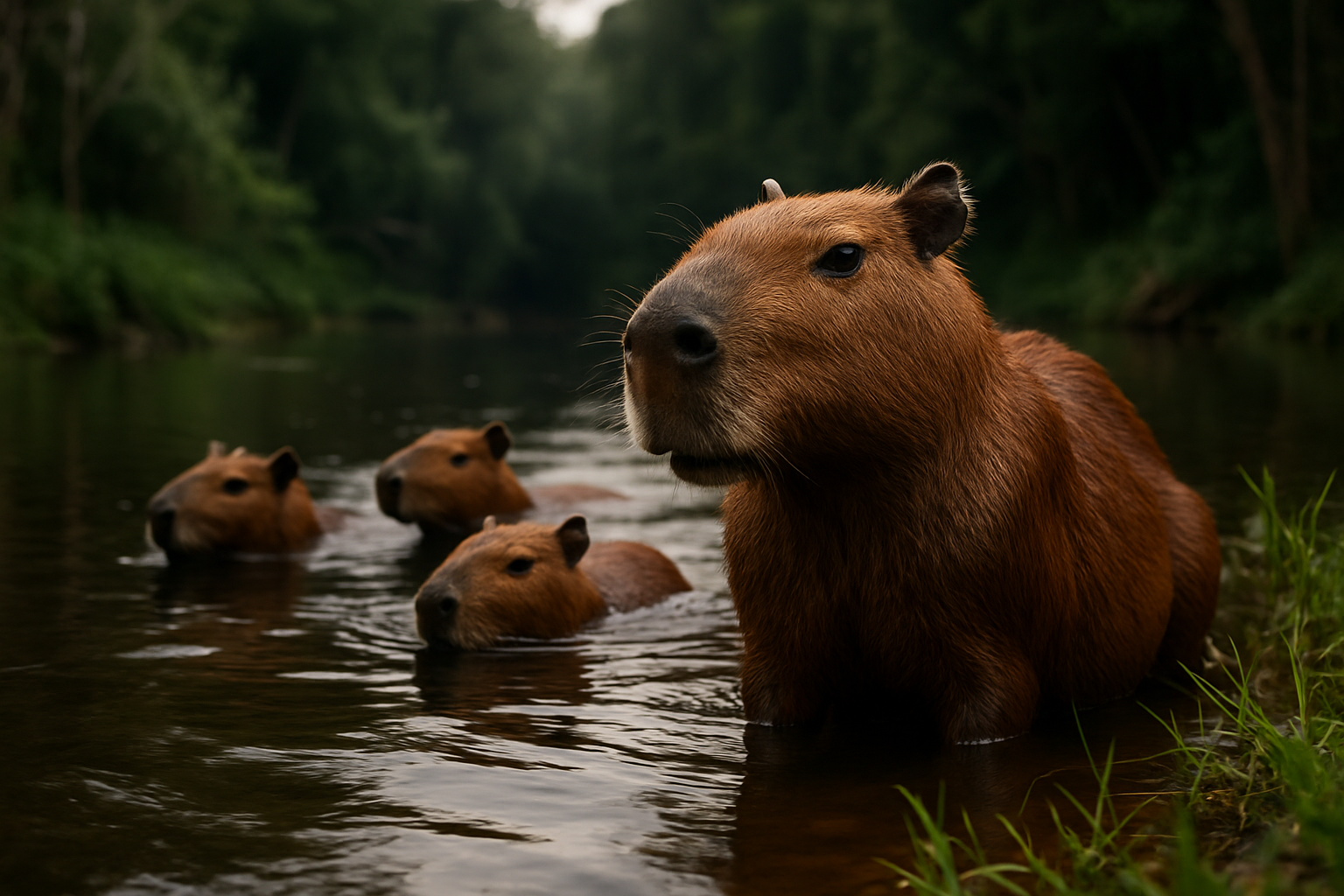The Hidden World of Capybara Social Dynamics
Imagine a rodent the size of a small dog, with webbed feet and a gentle demeanor, living in complex social groups that rival those of primates. Welcome to the fascinating world of capybaras, South America's largest rodents and masters of social interaction. These charismatic creatures have captivated animal enthusiasts and researchers alike with their unique behaviors and intricate social structures.

The Evolution of Capybara Sociality
Capybaras, scientifically known as Hydrochoerus hydrochaeris, have a long evolutionary history dating back millions of years. Their social behavior is believed to have evolved as a response to predation pressure and the need for efficient resource utilization in their semi-aquatic habitats. Unlike many other rodent species that live solitary lives or in small family groups, capybaras have developed a unique social structure that allows them to thrive in larger communities.
Fossil evidence suggests that the ancestors of modern capybaras began to show signs of increased sociality around 5 million years ago. This shift coincided with changes in South American ecosystems, including the expansion of grasslands and wetlands. As these habitats became more prevalent, capybaras adapted by forming larger groups, which provided better protection against predators and improved access to food and water resources.
Hierarchical Organization in Capybara Groups
One of the most intriguing aspects of capybara social dynamics is their hierarchical organization. Capybara groups, known as herds, typically consist of 10 to 20 individuals, although larger groups of up to 100 members have been observed in areas with abundant resources. Within these herds, a clear social hierarchy exists, with dominant males at the top of the pecking order.
The dominant male, often referred to as the alpha, plays a crucial role in maintaining group cohesion and defending territory. He earns his position through displays of strength and aggression, often engaging in ritualized fights with other males. These confrontations rarely result in serious injury, as they are primarily meant to establish and reinforce social rank.
Females also have their own hierarchy within the group, with older and more experienced individuals typically holding higher status. This hierarchical structure helps reduce conflict within the herd and ensures efficient decision-making when it comes to activities such as foraging and migration.
Cooperative Breeding and Alloparental Care
Perhaps one of the most remarkable aspects of capybara social behavior is their practice of cooperative breeding and alloparental care. In capybara herds, the responsibility of raising young is shared among multiple adults, not just the biological parents. This system, known as alloparental care, is relatively rare among mammals and showcases the high level of cooperation within capybara societies.
Pregnant females often synchronize their births, resulting in multiple litters being born within a short period. This synchronization allows for the formation of crèches, where several mothers pool their offspring and take turns caring for the young. Non-breeding adults, including both males and females, also participate in childcare duties, such as babysitting and even nursing.
This cooperative approach to child-rearing offers several advantages. It increases the survival rate of offspring by ensuring constant supervision and protection. It also allows mothers to forage more efficiently, as they can take turns watching over the young. Additionally, this system provides valuable parenting experience for younger or non-breeding individuals, preparing them for future reproductive success.
Communication and Social Bonding
Capybaras have developed a rich repertoire of vocalizations and body language to facilitate communication within their complex social groups. They use a variety of sounds, including barks, whistles, clicks, and purrs, to convey different messages and emotions. These vocalizations play a crucial role in maintaining group cohesion, alerting others to potential dangers, and coordinating group activities.
In addition to vocalizations, capybaras engage in numerous social bonding behaviors. Mutual grooming, or allogrooming, is a common practice that not only helps keep their fur clean but also strengthens social bonds between individuals. They also frequently engage in play behavior, especially among juveniles, which helps develop important social skills and reinforces group dynamics.
One particularly interesting aspect of capybara social bonding is their tendency to huddle together, both on land and in water. This behavior serves multiple purposes, including thermoregulation, protection from predators, and social reinforcement. The sight of a group of capybaras clustered together, often with younger individuals perched atop the adults, is a testament to the strong social bonds within these communities.
Implications for Conservation and Animal Welfare
Understanding the complex social dynamics of capybaras has important implications for both conservation efforts and animal welfare practices. As human activities continue to encroach upon capybara habitats, it is crucial to consider their social needs when developing conservation strategies. Preserving not just individual animals but entire social groups is essential for maintaining healthy capybara populations.
In captive settings, such as zoos and wildlife sanctuaries, knowledge of capybara social behavior is vital for ensuring the well-being of these animals. Providing opportunities for social interaction, maintaining appropriate group sizes, and mimicking natural social structures can significantly improve the quality of life for captive capybaras.
Furthermore, the study of capybara social dynamics offers valuable insights into the evolution of social behavior in mammals. By comparing capybara societies with those of other social species, researchers can gain a better understanding of the factors that drive the development of complex social structures in nature.
As we continue to unravel the mysteries of capybara social dynamics, these charismatic rodents remind us of the intricate and diverse ways in which animals can form societies. Their cooperative nature, complex communication systems, and strong social bonds offer a fascinating glimpse into the possibilities of social living in the animal kingdom, challenging our perceptions of rodent behavior and inspiring further exploration of the hidden social worlds that exist all around us.





